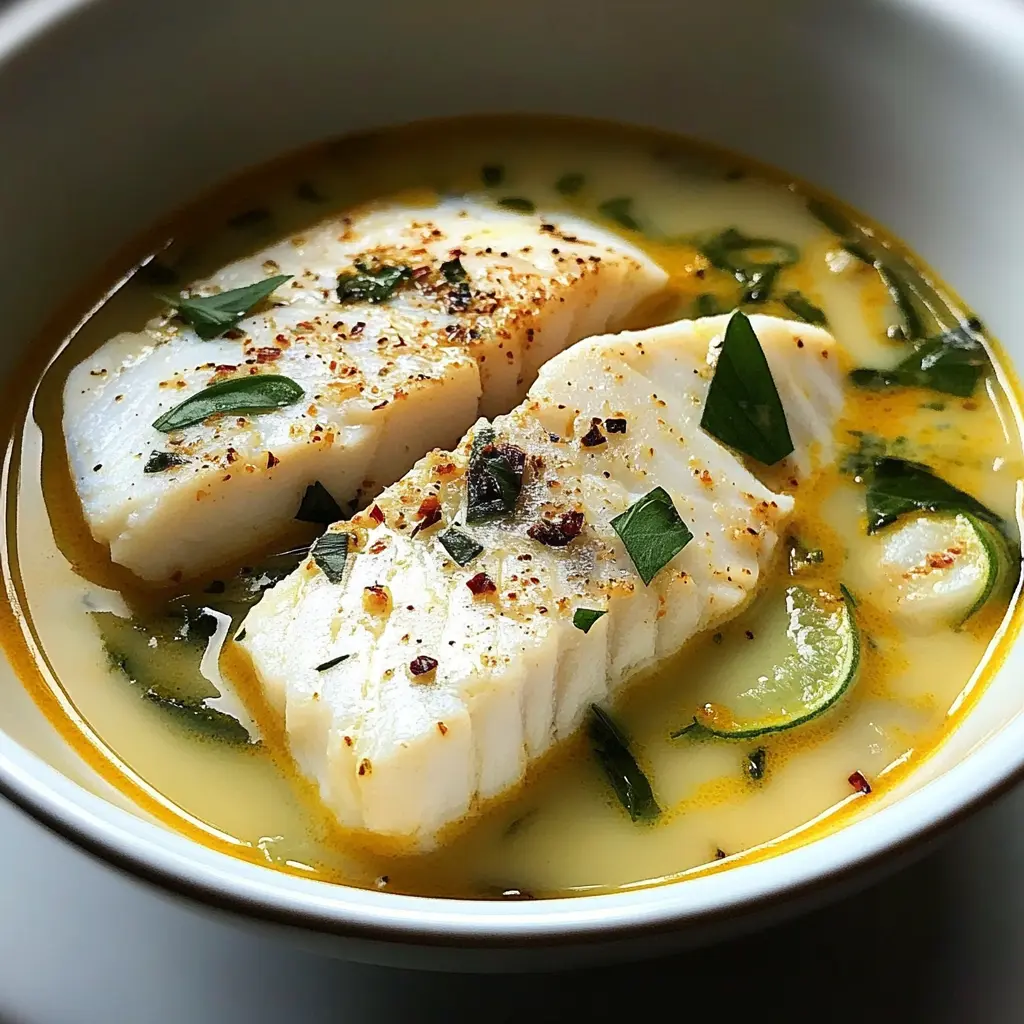Description of this recipe
This Creamy Coconut Lime Fish Soup is a symphony of flavors, blending the delicate taste of white fish with the richness of coconut milk, the tang of lime, and the warmth of fragrant spices. It’s a comforting and exotic dish that’s surprisingly easy to prepare, perfect for a weeknight dinner or a special occasion. Imagine a bowl brimming with tender flakes of fish, swimming in a velvety broth infused with ginger, garlic, and red curry paste, all brightened by the zesty notes of lime and the herbaceous aroma of cilantro. This soup is a celebration of Southeast Asian flavors, adapted for the home cook, and guaranteed to tantalize your taste buds.
Why you will love this recipe
You’ll fall in love with this Creamy Coconut Lime Fish Soup for several reasons. First, it’s incredibly quick and easy to make, requiring minimal effort and readily available ingredients. Second, it’s a healthy and nutritious meal, packed with lean protein from the fish, healthy fats from the coconut milk, and essential vitamins and minerals from the vegetables and spices. Third, it’s incredibly versatile. You can easily customize the recipe to suit your preferences by using different types of fish, adding more or less chili for heat, or incorporating other vegetables like mushrooms, bell peppers, or spinach. Finally, and most importantly, it’s absolutely delicious! The combination of creamy, tangy, spicy, and savory flavors is simply irresistible, making it a dish you’ll want to make again and again. This soup is a guaranteed crowd-pleaser, perfect for impressing your friends and family with your culinary skills. It’s a delicious and comforting way to enjoy the flavors of Southeast Asia without having to travel!
Ingredients:
- 1 lb white fish fillets (such as cod, halibut, or tilapia), cut into 1-inch pieces
- 1 tbsp olive oil
- 1 medium onion, finely chopped
- 3 garlic cloves, minced
- 1 tbsp fresh ginger, grated
- 1 tbsp red curry paste
- 1 can (14 oz) full-fat coconut milk
- 2 cups fish or vegetable broth
- 1 tbsp fish sauce
- Juice of 2 limes, plus extra wedges for serving
- 1 red chili, finely chopped (optional, for extra heat)
- Salt and pepper, to taste
- Fresh cilantro, chopped, for garnish
Preparation:
Step 1: Prepare the Fish: Rinse the fish fillets under cold water and pat them dry with paper towels. This removes any lingering fishy odors and helps the fish to cook evenly. Cut the fillets into 1-inch pieces. Season the fish pieces generously with a pinch of salt and freshly ground black pepper. Set the seasoned fish aside.
Step 2: Sauté the Aromatics: In a large pot or Dutch oven, heat the olive oil over medium heat. Once the oil is shimmering, add the finely chopped onion and cook, stirring occasionally, until the onion is softened and translucent, about 3-4 minutes. Be careful not to brown the onion too much, as this can impart a bitter flavor to the soup.
Step 3: Add the Flavor Base: Stir in the minced garlic, grated fresh ginger, and red curry paste to the pot. Cook for another 1-2 minutes, stirring constantly, until the spices are fragrant. This step is crucial for releasing the essential oils in the garlic, ginger, and curry paste, which will infuse the soup with its distinctive flavor.
Step 4: Simmer the Soup: Pour in the coconut milk and fish or vegetable broth, stirring to combine all the ingredients. Bring the mixture to a gentle simmer. Reduce the heat to low and let the soup simmer for about 10 minutes, allowing the flavors to meld together. Simmering the soup allows the coconut milk to thicken slightly, creating a richer and creamier texture.
Step 5: Poach the Fish: Gently add the seasoned fish pieces to the simmering soup. Let the fish poach for about 5-8 minutes, or until the fish is cooked through and flakes easily with a fork. Be careful not to overcook the fish, as it can become dry and rubbery. The cooking time will vary depending on the thickness of the fish fillets.
Step 6: Finish and Season: Stir in the fish sauce, lime juice, and chopped red chili (if using). Adjust the seasoning with salt and pepper to taste. The fish sauce adds a savory umami flavor to the soup, while the lime juice brightens the flavors and adds a refreshing tang. The red chili provides a welcome kick of heat, but can be omitted for those who prefer a milder soup.
Step 7: Garnish and Serve: Ladle the Creamy Coconut Lime Fish Soup into bowls and garnish generously with fresh cilantro. Serve immediately with lime wedges on the side for squeezing. The fresh cilantro adds a vibrant burst of flavor and color to the soup, while the lime wedges allow each person to customize the acidity to their liking.
COOKING Rating:
- Ease of Preparation: Easy
- Flavor Complexity: Medium
- Spice Level: Mild to Medium (adjustable)
- Overall: 5/5 stars
Serving Suggestions:
- Serve hot as a main course for lunch or dinner.
- Pair with a side of steamed jasmine rice or crusty bread for soaking up the flavorful broth.
- Offer additional toppings such as bean sprouts, shredded carrots, or chopped peanuts for added texture and flavor.
- Serve with a refreshing cucumber salad or a side of stir-fried vegetables for a complete meal.
Tips:
- For a richer flavor, use full-fat coconut milk.
- If you don’t have fish sauce, you can substitute soy sauce or tamari.
- Adjust the amount of red curry paste and chili to your preferred level of spiciness.
- Don’t overcook the fish, as it will become dry and rubbery.
- For a vegetarian version, substitute tofu for the fish and use vegetable broth instead of fish broth.
Prep Time: 15 minutes
Cook Time: 25 minutes
Total Time: 40 minutes
Nutritional Information: (Approximate, per serving)
- Calories: 350-400
- Protein: 30-35g
- Sodium: 500-700mg (depending on fish sauce and broth)
Conclusion
This Creamy Coconut Lime Fish Soup is more than just a recipe; it’s an experience. It’s a journey to the vibrant flavors of Southeast Asia, all within the comfort of your own kitchen. It’s a dish that’s both comforting and exciting, familiar and exotic. Whether you’re a seasoned cook or a beginner in the kitchen, this recipe is guaranteed to impress. So, gather your ingredients, put on some music, and prepare to be transported to a world of deliciousness. This Creamy Coconut Lime Fish Soup is a culinary adventure that you won’t soon forget. It’s sure to become a staple in your recipe rotation!
Questions and Answers about this Recipe:
Q1: Can I use frozen fish fillets instead of fresh?
A: Yes, absolutely! Frozen fish fillets work perfectly well in this recipe. Just make sure to thaw them completely before cooking and pat them dry with paper towels to remove any excess moisture. Thawing the fish beforehand ensures that it cooks evenly and doesn’t water down the soup.
Q2: I don’t have red curry paste. Can I use another type of curry paste?
A: Yes, you can substitute green curry paste or yellow curry paste, but the flavor will be slightly different. Red curry paste tends to be a bit spicier and more robust in flavor, while green curry paste is typically milder and more herbaceous. Yellow curry paste has a milder and sweeter flavor profile. Adjust the amount of curry paste to your liking, depending on your spice preference.
Q3: I’m allergic to fish. Can I substitute another protein source?
A: Yes, you can easily substitute tofu or shrimp for the fish in this recipe. Tofu will need to be pressed to remove excess water before being added to the soup. Shrimp should be added towards the end of the cooking process, as they cook very quickly. You can also use chicken, just make sure it is fully cooked.
Q4: Can I make this soup ahead of time?
A: While the soup is best served fresh, you can make it ahead of time and store it in the refrigerator for up to 2 days. However, keep in mind that the fish may become slightly less tender when reheated. When reheating, do so gently over low heat to prevent the fish from overcooking.
Q5: What other vegetables can I add to this soup?
A: The possibilities are endless! Some great additions include mushrooms, bell peppers, spinach, bok choy, carrots, or zucchini. Add them along with the coconut milk and broth, allowing them to cook until tender. Be sure to adjust the cooking time depending on the vegetables you choose.




